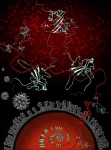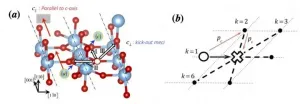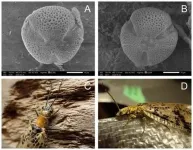Deep dive into key COVID-19 protein is a step toward new drugs, vaccines
2021-04-05
(Press-News.org) CORVALLIS, Ore. - Researchers in the Oregon State University College of Science have taken a key step toward new drugs and vaccines for combating COVID-19 with a deep dive into one protein's interactions with SARS-CoV-2 genetic material.
The virus' nucleocapsid protein, or N protein, is a prime target for disease-fighting interventions because of the critical jobs it performs for the novel coronavirus' infection cycle and because it mutates at a comparatively slow pace. Drugs and vaccines built around the work of the N protein carry the potential to be highly effective and for longer periods of time - i.e., less susceptible to resistance.
Among the SARS-CoV-2 proteins, the N protein is the viral RNA's biggest partner. The RNA holds the genetic instructions the virus uses to get living cells, such as human cells, to make more of itself, and the N protein binds to the RNA and protects it.
Published in Biophysical Journal, the findings are an important jump-off point for additional studies of the N protein and its interactions with RNA as part of a thorough look at the mechanisms of SARS-CoV-2 infection, transmission and control.
Elisar Barbar, professor of biochemistry and biophysics at Oregon State, and Ph.D. candidate Heather Masson-Forsythe led the study with help from undergraduate students Joaquin Rodriguez and Seth Pinckney. The researchers used a range of biophysical techniques that measure changes in the size and shape of the N protein when bound to a fragment of genomic RNA - 1,000 nucleotides of the 30,000-nucleotide genome.
"The genome is rather large for a virus and requires many copies of the N protein to stick to the RNA to give the virus the spherical shape that is necessary for the virus to make more copies of itself," Barbar said. "Our study helps us quantify how many copies of N are needed and how close they are to each other when they stick to the RNA. "
Biophysical studies of N with large segments of RNA by nuclear magnetic resonance are rare, Barbar said, because of the difficulty of preparing the partially disordered N protein and long RNA segments, both prone to aggregation and degradation, but these kinds of studies are a specialty of the Barbar lab. Other researchers' studies generally have been limited to much smaller pieces of RNA and smaller pieces of the N protein.
Rather than just looking at the RNA-binding regions of the N protein on their own, the 1,000-nucleotide view allowed scientists to learn that the protein binds much more strongly when it's a full-length dimer - two copies attached to one another - and to identify regions of the protein that are essential for RNA binding.
"The full protein has structured parts but is actually really flexible, so we know that this flexibility is important for RNA binding," Masson-Forsythe said. "We also know that as N proteins start to bind to the longer RNA, the result is a diverse collection of bound protein/RNA complexes as opposed to one way of binding."
Drugs that thwart the N protein's flexibility would thus be one potential avenue for pharmaceutical researchers, she said. Another possibility would be drugs that disrupt any of those protein/RNA complexes that prove to be of special significance.
INFORMATION:
A National Science Foundation Early-concept Grant for Exploratory Research (EAGER) supported this research through the NSF's Division of Molecular and Cellular Biosciences. The Oregon State nuclear magnetic resonance facility used in the study is funded in part by the National Institutes of Health and the M.J. Murdock Charitable Trust, and the NIH also supported the native mass spectrometry data acquisition portion of the research.
Zhen Yu, Richard Cooley, Phillip Zhu and Patrick Reardon of Oregon State and James Prell and Amber Rolland of the University of Oregon were the other researchers on the project.
[Attachments] See images for this press release:

ELSE PRESS RELEASES FROM THIS DATE:
2021-04-05
Ishikawa, Japan - One of the most important classes of problems that all scientists and mathematicians aspire to solve, due to their relevance in both science and real life, are optimization problems. From esoteric computer science puzzles to the more realistic problems of vehicle routing, investment portfolio design, and digital marketing--at the heart of it all lies an optimization problem that needs to be solved.
An appealing technique often used in solving such problems is the technique of "quantum annealing", a framework that tackles optimization problems by using "quantum tunneling"--a quantum physical phenomenon--to pick out an optimum solution out of several candidate solutions. ...
2021-04-05
INDIANAPOLIS -- The high incidence of COVID-19 and resulting sudden changes in the health of many long-stay nursing home residents across the country have amplified the importance of advance care planning and the need for periodic review of the process, especially as widespread vaccination changes the calculus of the disease.
Two new studies from Indiana University and Regenstrief Institute focus on POLST, a medical order form widely used in nursing homes that documents what life-sustaining treatments a person prefers to receive or not receive, such as hospitalization or comfort-focused care. The studies, published online ...
2021-04-05
Researchers from Kumamoto University (Japan) have found that adult nocturnal fishflies (Neochauliodes amamioshimanus), which are typically aquatic insects, feed on pollen at night. They also present circumstantial evidence suggesting that this species not only forages in flowers, but is also a supplementary pollinator. Their work sheds light on the terrestrial life of adult fishflies, which has been a mystery until now.
Megaloptera is a small taxon (about 400 species worldwide) consisting of the families Sialidae (alderflies) and Corydalidae (dobsonflies and fishflies), and is considered to be one of the oldest groups of insects that undergo complete metamorphosis. The biology of the fishfly's aquatic larvae, which were sometimes used as folk remedies in Japan, is relatively well understood. ...
2021-04-05
WASHINGTON, April 5, 2021 -- As the world awaits the upcoming Olympic games, a new method for detecting doping compounds in urine samples could level the playing field for those trying to keep athletics clean. Today, scientists report an approach using ion mobility-mass spectrometry to help regulatory agencies detect existing dopants and future "designer" compounds.
The researchers will present their results today at the spring meeting of the American Chemical Society (ACS). ACS Spring 2021 is being held online April 5-30. Live sessions will be hosted April 5-16, and on-demand and networking content will continue through April 30. The meeting features nearly 9,000 presentations ...
2021-04-05
WASHINGTON, April 5, 2021 -- Polyurethanes, a type of plastic, are nearly everywhere -- in shoes, clothes, refrigerators and construction materials. But these highly versatile materials can have a major downside. Derived from crude oil, toxic to synthesize, and slow to break down, conventional polyurethanes are not environmentally friendly. Today, researchers discuss devising what they say should be a safer, biodegradable alternative derived from fish waste -- heads, bones, skin and guts -- that would otherwise likely be discarded.
The researchers will present their results today at the spring meeting of the American Chemical Society (ACS). ACS Spring 2021 is being held online April 5-30. Live sessions will be hosted ...
2021-04-05
WASHINGTON, April 5, 2021 -- For centuries, people in Baltic nations have used ancient amber for medicinal purposes. Even today, infants are given amber necklaces that they chew to relieve teething pain, and people put pulverized amber in elixirs and ointments for its purported anti-inflammatory and anti-infective properties. Now, scientists have pinpointed compounds that help explain Baltic amber's therapeutic effects and that could lead to new medicines to combat antibiotic-resistant infections.
The researchers will present their results today at the spring meeting of the American Chemical Society (ACS). ACS Spring 2021 is being held online ...
2021-04-05
DALLAS, April 5, 2021 -- When people with human immunodeficiency virus (HIV) develop high blood pressure, the type of medication chosen for their initial treatment may influence their risk of heart disease, stroke and heart failure, according to new research published today in Hypertension, an American Heart Association journal.
With current anti-retroviral medications, people with HIV are able to live longer. However, people with HIV receiving anti-retroviral therapy (ART) are more likely to develop high blood pressure (hypertension) and hypertension-related heart problems than people who do not have the virus. The current study is the first to examine how the choice of blood pressure medications influences the long-term risk of heart disease, stroke and ...
2021-04-05
New research shows the permanent rise of oxygen in our atmosphere, which set the stage for life as we know it, happened 100 million years later than previously thought.
A significant rise in oxygen occurred about 2.43 billion years ago, marking the start of the Great Oxidation Episode -- a pivotal moment in Earth's history.
An international research team including a UC Riverside scientist analyzed rocks from South Africa formed during this event. Findings, published this week in the journal Nature, include the discovery that oxygen fluctuated dramatically after its early appearance until it became a permanent constituent of the atmosphere much later.
These ...
2021-04-05
Researchers at the National Institutes of Health have developed a breath test that measures how well patients with methylmalonic acidemia (MMA) respond to receiving liver or combined liver and kidney transplantation. Researchers also used the test to assess the severity of the disease in people and help determine if they would benefit from surgical or experimental genomic therapies that target the liver. The study results were published in Genetics in Medicine. Scientists at the National Human Genome Research Institute (NHGRI) led the project team, with collaborators from the National ...
2021-04-05
Rates of prolonged visits for pediatric mental health emergency department (ED) visits increased over a decade, in contrast to non-mental health visits for which visit times remained stable, according to a study published in the journal Pediatrics. From 2005-2015, rates of ED visits lasting over six hours for children presenting for mental health issues jumped from 16 percent to nearly 25 percent, while rates of visits lasting over 12 hours increased from 5 percent to nearly 13 percent.
"The trend of increasingly long ED visits for pediatric mental health problems likely represents worsening access to essential mental health services. This is concerning, especially since during the COVID-19 pandemic we are seeing substantially more children coming ...
LAST 30 PRESS RELEASES:
[Press-News.org] Deep dive into key COVID-19 protein is a step toward new drugs, vaccines






